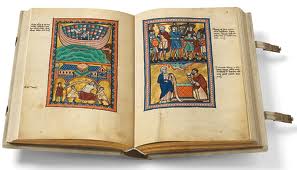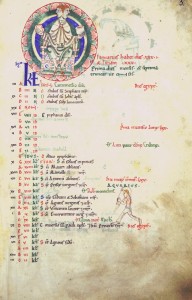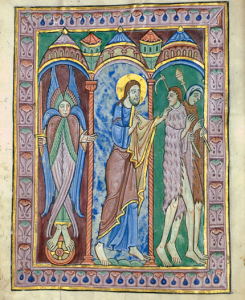The St. Albans Psalter, despite having been around for 900 years, has not had (comparatively speaking) very much research done on it outside of the illuminations. In fact, they are so remarkable they have by far overshadowed the text for centuries. However, recent studies have begun questioning the origin of the manuscript, and further, its purpose.
It was for several decades presupposed the Psalter originally belonged to Christina of Markyate, who confined herself to St. Albans at around the age of eighteen after abandoning her betrothal and taking a vow of chastity. The dates are not entirely known, but it was circa 1110, and the Psalter was most likely created in between 1120 and 1140. While Christina played an integral part at St. Albans, it is now accepted that it was not entirely her history within the walls of the monastery that was documented within the Psalter, and it perhaps served a different purpose altogether. Closer examination shows multiple additions as it changed hands over time, and by tracing the scribal notations it can be theorized as to its various uses.
I have to admit this post is about a year late as it originated with my viewing of the Psalter at the Getty Museum last January and then later attending the conference in early February where a marvelous panel of scholars who worked personally with the Psalter shared their findings.
I finally finished reading one of the most recent and authoritative texts on the manuscript (Collins, Kidd, and Turner), but there are still many things unknown, or addressed about the manuscript. Two such things caught my attention, and are of most interest for future research – should the fantastic opportunity arise.
The first concerns the Psalter’s calendar at the beginning of the manuscript. As has already been stated by several scholars, it is not a liturgical calendar. Most who would be familiar with liturgical calendars would immediately note the sparsity of entries, with many significant dates left out. This initially indicates that the calendar was created for private use, made further evident by the inclusion of personal dates (birth dates and obits relevant only to a few). However, what is of interest are the additions made to the calendar. They are written in a different ink by a different hand. At what point they were added is unknown (this is different from dates like obits that were continuously added as they happened). Many of the additions reflected holy days that were not initially included, making the calendar at first glance appear more official. In other words, it was purposely made to look like a liturgical calendar. Yet there are still a great number of important dates omitted. When the decision was made to begin remodeling it, it is unknown who made this decision, why, and how it was decided what dates would be included.
(St. Albans Psalter, folio 3r – On the first month of the calendar, January, on the 11th we can see the obit for Christina’s father. This is obviously a personal detail that connects her with the book above others since the obits for the parents of others connected with St. Albans at the time were not inscribed in the calendar. However, in the same month we do see various obits for other church members that were more than likely housed at St. Albans, or in close vicinity)
(St. Albans Psalter, folio 3r close-up “Auti pater do[mi]n[a]e Cristin[a]e” – This sort of personalization of the book continues onto every month of the calendar, and in many places the names mentioned are untraceable, with only speculations left to be made)
My first instinct was to attribute these insertions to scribal decision making, but that seems like a rather knee jerk reaction to a difficult (and perhaps unanswerable) question. While it is quite likely that the scribe was also a monk at the monastery who would be able to distinguish which dates were for personal use and which were pertinent in a broader sense, it appears there was a lot of picking and choosing that went into the development of the calendar in its later days.
N. Morgan’s theory regarding this has to do with the amount of saint’s names, specifically women, returning to the tie in with Christina who started a nunnery on the premises of St. Albans. Even if it is no longer accepted that the book was made for her, the amount of her relatives that are mentioned in the obits maintains her connection to the book, and adds to the possibility that it was used in her nunnery as opposed to the main church. And while this accounts for the numerous female saints listed, and even more so for the various virgins who were never official saints but entered in the book nonetheless, there is something more there that needs discovery.
The calendar is a perpetual calendar that spans 28 years, altering between fixed and movable dates for each month. However, the actual years need to be calculated cyclically (through the use of kalends – the first day of the month), making it very difficult to realize at what point during the calendar’s existence events and names were added. However, I am not going to describe the entire methodology of calendar reading in its technical sense since it is not necessary to understanding the final inquiry.
And I am calling it an inquiry because I have no actual conclusion. I have a few speculations based on observations, but the main question will for now remain unanswered. My first theory is that the various additions were made in two groupings. As Morgan stipulated, there is in fact a chunk of names which were added to indicate the role the book held at a convent. But there are other dates which were also later additions, written in a very different hand, that have seemingly little to do with the convent. The entirety of the Psalter is written by a total of 6 scribes, and three of them worked on the calendar section – the primary calendar before additions, the convent additions (my own terminology for lack of a better identifier), and the last additions. I think the key to understanding the appropriation of the Psalter can be found in further studying the last of these two, essentially working backwards in the calendar through the cycles to figure out at what point during the 28 year span each scribe worked at it, in conjuncture with the other parts of the book to identify a correlation between calendar additions and overall editing/additions/deletions throughout the text. If enough movement of text happened in intervals at specific points, then it can lead to an interpretation of how the text function, and perhaps even its original intent. Nevertheless, I must note that this is also contingent upon picking a more definite date for the Psalter’s origin, otherwise counting the years in either direction will be of little use.
The second item that grabbed my attention was an illumination on folio 18v. Very little commentary exists on it other than a description: three pictures describing the expulsion of Adam and Eve from paradise and the posting of the Cherub at the gate.
Although the intricate details of the artwork are beautiful, what I want to convey is the placement of the images. Three things are happening here that don’t appear quite right.
The stories of the expulsion of Adam and Eve and of the later posting of the Cherub are here conflated into a single triptych image. Considering the psalter in its entirety is over 400 pages long, economy of space was not an issue. It was purposely conflated. Why?
God is expelling Adam and Eve as opposed to an angel. While this is odd, it is also the only oddity for which scholars have an answer; it falls in line with Anglo-Saxon convention, and the depiction is not unique to the St. Albans Psalter.
The last strange piece which (when looking at the actual picture) is immediately obvious and for which there is the most commentary, has to do with the ordering of the narrative. Cherub-God-Adam and Eve. The story is inverted, and in following with the original the Cherub was posted at the gates *after* the expulsion, not before (a small but notable point). For a book in which the hundreds of pictures are so impeccable, this seems most idiosyncratic, and most likely intentional.
Unlike with the calendar where further developments and research could perhaps illustrate the sequencing of text as it was written, providing answers, or at best more speculations in regards to its uses, the pictorials are more difficult and the research that needs to be conducted is actually outside of the Psalter, relying on other texts that would hint towards various interpretations of well known narratives (within temporal proximity). Currently not enough is known on localized perceptions and how (or if) they played into the creation of this work. I think ultimately devising its origins and primary intentions will widen (and paradoxically narrow) the scope of what we should be looking for.
Sources:
Collins, Kristen, Kidd, Peter Kidd and Nancy Turner. The St. Albans Psalter.
Geddes, Jane. The St Albans Psalter: A Book for Christina of Markyate.
Haney, Kristine Edmondson. St. Albans Psalter.
Haney, Krisine Edmondson. The Illuminated Psalter: Studies in the Content, Purpose and Placement of Its Images.
L’Hermite-Leclerq and Anne Marie Legras. Vie de Christina de Markyate.
Talbot, C.H. The Life of Christina of Markyate A Twelfth Century Recluse.









